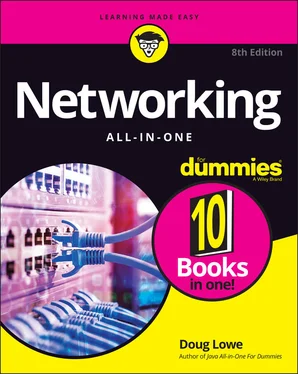1 ...7 8 9 11 12 13 ...45 Instead of keeping separate copies of programs on each person’s computer, put programs on a drive that everyone shares. For example, if ten computer users all use a particular program, you can purchase and install ten copies of the program, one for each computer. Or you can purchase a ten-user license for the program and then install just one copy of the program on a shared drive. Each of the ten users can then access the program from the shared hard drive.
 Remember that purchasing a single-user copy of a program and then putting it on a shared network drive — so that everyone on the network can access it — is illegal. If five people use the program, you need to either purchase five copies of the program or purchase a network license that specifically allows five or more users.
Remember that purchasing a single-user copy of a program and then putting it on a shared network drive — so that everyone on the network can access it — is illegal. If five people use the program, you need to either purchase five copies of the program or purchase a network license that specifically allows five or more users.
 That being said, many software manufacturers sell their software with a concurrent usage license, which means that you can install the software on as many computers as you want, but only a certain number of people can use the software at any given time. Usually, special licensing software that runs on one of the network’s server computers keeps track of how many people are currently using the software. This type of license is frequently used with more specialized (and expensive) software, such as accounting systems or computer drafting systems.
That being said, many software manufacturers sell their software with a concurrent usage license, which means that you can install the software on as many computers as you want, but only a certain number of people can use the software at any given time. Usually, special licensing software that runs on one of the network’s server computers keeps track of how many people are currently using the software. This type of license is frequently used with more specialized (and expensive) software, such as accounting systems or computer drafting systems.
Another common method for software vendors to license their software is through a monthly or yearly subscription. You just give them your credit card number, and they give you the right to use the software. You need a working Internet connection so that the software can confirm that you have a valid subscription each time you run the software.
Another benefit of networking is that networks enable computer users to communicate with one another over the network. The most obvious way networks allow computer users to communicate is by passing messages back and forth, using email or instant-messaging programs. Networks also offer other ways to communicate: For example, you can hold online meetings over the network. Network users who have inexpensive video cameras (webcams) attached to their computers can have videoconferences. You can even play a friendly game of Hearts over a network — during your lunch break, of course.
The network computer that contains the hard drives, printers, and other resources that are shared with other network computers is a server. This term comes up repeatedly, so you have to remember it. Write it on the back of your left hand.
Any computer that’s not a server is a client. You have to remember this term, too. Write it on the back of your right hand.
Only two kinds of computers are on a network: servers and clients. Look at your left hand and then look at your right hand. Don’t wash your hands until you memorize these terms.
The distinction between servers and clients in a network has parallels in sociology — in effect, a sort of class distinction between the “haves” and “have-nots” of computer resources:
Usually, the most powerful and expensive computers in a network are the servers. There’s a good technical reason: All users on the network share the server’s resources.
The cheaper and less-powerful computers in a network are the clients. Clients are the computers used by individual users for everyday work. Because clients’ resources don’t have to be shared, they don’t have to be as fancy. (The exception to this rule is if the users do work that requires powerful desktop computers — for example, engineering design or video processing.)
Most networks have more clients than servers. For example, a network with ten clients can probably get by with one server, but larger networks will likely require more servers.
In most networks, a clean line of demarcation exists between servers and clients. In other words, a computer functions as either a server or a client, not both. For the sake of an efficient network, a server can’t become a client, nor can a client become a server.
Other (usually smaller) networks can be more evenhanded by allowing any computer in the network to be a server and allowing any computer to be both a server and a client at the same time.
Dedicated Servers and Peers
In most networks, a server computer is a server computer and nothing else. It’s dedicated to the sole task of providing shared resources, such as hard drives and printers, to be accessed by the network client computers. This type of server is a dedicated server because it can perform no other task than network services.
Some smaller networks take an alternative approach by enabling any computer on the network to function as both a client and a server. Thus, any computer can share its printers and hard drives with other computers on the network. And while a computer is working as a server, you can still use that same computer for other functions, such as word processing. This type of network is a peer-to-peer network because all the computers are thought of as peers, or equals.
Here are some points to ponder concerning the differences between dedicated-server networks and peer-to-peer networks while you’re walking the dog tomorrow morning:
Peer-to-peer networking features are built into Windows. Thus, if your computer runs Windows, you don’t have to buy any additional software to turn your computer into a server. All you have to do is enable the Windows server features.
The network server features that are built into Windows 10 (the most popular desktop operating system) aren’t particularly efficient because this version of Windows wasn’t designed primarily to be a network server. If you dedicate a computer to the task of being a full-time server, use a special server operating system rather than the standard Windows desktop operating system. A server operating system is specially designed to handle networking functions efficiently.The most commonly used server operating systems are the server versions of Windows. As of this writing, the current server version of Windows is Windows Server 2019. However, many companies still use the previous version (Windows Server 2016), and a few use even earlier versions such as Windows Server 2012 and 2008.Another popular server operating system is Linux . Linux is popular because it’s free. Linux requires more expertise to set up than Windows Server but is just as capable.
Many networks are both peer-to-peer and dedicated-server networks at the same time. These networks haveAt least one server computer that runs a server operating system such as Windows Server 2019Client computers that use the server features of Windows 10 to share their resources with the network
Besides being dedicated, your servers should also be sincere.
What Makes a Network Tick?
To use a network, you don’t really have to know much about how it works. Still, you may feel a little bit better about using the network if you realize that it doesn’t work by voodoo. A network may seem like magic, but it isn’t. The following list describes the inner workings of a typical network:
Network interface: Inside any computer attached to a network is a special electronic circuit called the network interface. The network interface has either an external jack into which you can plug a network cable — or, in the case of a wireless network interface, an antenna.
Читать дальше

 Remember that purchasing a single-user copy of a program and then putting it on a shared network drive — so that everyone on the network can access it — is illegal. If five people use the program, you need to either purchase five copies of the program or purchase a network license that specifically allows five or more users.
Remember that purchasing a single-user copy of a program and then putting it on a shared network drive — so that everyone on the network can access it — is illegal. If five people use the program, you need to either purchase five copies of the program or purchase a network license that specifically allows five or more users. That being said, many software manufacturers sell their software with a concurrent usage license, which means that you can install the software on as many computers as you want, but only a certain number of people can use the software at any given time. Usually, special licensing software that runs on one of the network’s server computers keeps track of how many people are currently using the software. This type of license is frequently used with more specialized (and expensive) software, such as accounting systems or computer drafting systems.
That being said, many software manufacturers sell their software with a concurrent usage license, which means that you can install the software on as many computers as you want, but only a certain number of people can use the software at any given time. Usually, special licensing software that runs on one of the network’s server computers keeps track of how many people are currently using the software. This type of license is frequently used with more specialized (and expensive) software, such as accounting systems or computer drafting systems.










